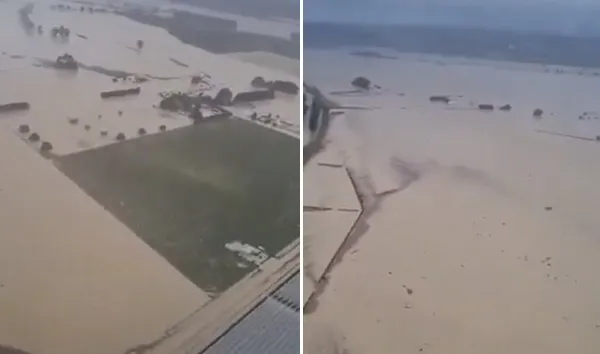New Zealand is dealing with the aftermath of Cyclone Gabrielle which hit the country on Monday night. Prime Minister Chris Hipkins has called Gabrielle the biggest weather event to hit the country in the last century. It is estimated to have affected at least a third of the country’s five million population. A state of emergency has been declared in the country.
The cyclone has caused significant flooding and landslides across the North Island, at least four people have died and several are missing. Hundreds have had to be rescued from rooftops and many towns remain cut off by flood water and around 225,000 people have been without power.
The damage is worst in coastal areas in the far north and east coast of the North Island – Hawkes Bay, Coromandel and Northland are among the worst hit.
Fruit and vegetable producers were already suffering after excessive rain through the summer and a recent massive downpour which caused a state of emergency to be declared in Auckland at the beginning of February.

Photo: @pwapwap
Click to watch Chopper footage @pwapwap
Kiwifruit
It is early days and so difficult to ascertain the extent of any damage said NZKGI CEO Colin Bond.
“As Cyclone Gabrielle continues to travel across most of New Zealand’s kiwifruit growing regions, some extent of impact is expected for the kiwifruit industry. While our thoughts are with impacted growers, the cyclones full extent is unknown at this time as the situation continues to evolve. NZKGI also recognises that some growers continue to deal with the recent flooding from the beginning of this month.
"Roots of kiwifruit vines that are under water from floods for extended periods of time suffer from oxygen starvation which can ultimately kill the vines. In addition, there is also a wider concern with the recent climatic conditions, including lack of sunlight hours, may impact on fruit growth as harvest approaches. Assessments of the extent of any impact that these issues may have on this year’s harvest, which is expected to begin in the coming weeks, are currently being made.”
Avocado
Jen Scoular, CEO of NZ Avocado said avocado orchards were already unseasonably wet, and a further 200-300ml rain came down Friday and Sunday through Tuesday.
“Severe winds came from the west but then turned from the East causing real damage to large trees, or large branches of trees. But it seems the most damage might be to very young trees, knocked over completely. Growers were urged yesterday not to go out while winds were still raging so many are yet to assess the full damage. Power & telecommunications are down across a number of areas in the north island making it difficult to share updates. Coastal regions in the Bay of Plenty have also been impacted by the winds in particular.”
The NZ export season is largely finished, but growers would normally hold enough fruit to supply the NZ market through until April/May when the new season avocados mature.
“Much of that fruit may have been knocked off with the high winds. Some very relevant advice on managing storm damage on orchards is shared with our growers via our website. Growers are not yet unable to assess the impact on their next season crop which set in November 2022. Much new fruit has been either knocked about by wind or blown off the tree.”
Apples
The NZ apple harvest is also underway and workers have been evacuated to safety. "Some workers were stranded on the roof of their accommodation on Tuesday after nearby rivers burst their banks due to the unprecedented weather. The workers are now safe in temporary accommodation and are being supported by our dedicated welfare team. We are thankful for the support of emergency services who were able to reach our people and get them to safety,” said Gary Jones at Mr Apple to www.nzherald.co.nz
”The first priority is the safety and wellbeing of all Mr Apple people and would like to reassure the families of our Pacific workers that everyone is safe, and we are supporting them,” he said.
”We are working hard to establish the location and safety of all our team across the wider Hawke’s Bay region and provide necessary support, especially to those who have been evacuated from their homes.”
He said that as for everyone in the region, Mr Apple is challenged with extremely limited communications and physical access, but continues to focus on the wellbeing of people first.
A spokesperson for Leaderbrand, a fresh produce grower and supplier with growers in the North and South Island, said there would be shortages of fresh produce this week.
"Gisborne was completely cut off, and there was no way to communicate with anyone, We won’t know the extent of the damage until tomorrow. There will be shortages on product this week,” she told www.stuff.co.nz
High swells around the Port of Tauranga have also led to the suspension of all vessel callings at the port reports www.porttechnology.org
Additionally, the Ports of Auckland will release all berthed ships, and no ship will be allowed to berth until 15 February. However, it may take longer depending on how precarious the situation remains.
Napier Port has been closed since 3:00 pm local time on 13 February
There are major supply chain issue as landslides and flooding have made deliveries of food impossible in some areas.
